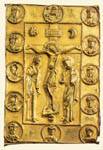|
|
| Byzantine Minor Arts |
13th14th c. Protaton Silver gilt 18.5 x 12 x 1 cm |
|

|
Only one side of the metal cover, probably made for the binding of a Gospel, has been preserved. It is decorated in repoussι work, with the Crucifixion surrounded by eleven medallions framing busts of saints, and a twelfth, directly above the cross, with the Hetoimasia. Both the series of medallions and the scene of the Crucifixion are framed by a narrow beaded border. The composition of the Crucifixion, with the dead Christ on the cross and the figures of the Virgin and St John expressing in their attitude and gestures a reserved grief, displays a successful blend of Western and Byzantine iconographic features. One detail which is particularly worthy of remark is the fact that John (identified by the inscription as St John the Theologian), who is holding the Gospel in his left hand, right hand brought up to his face in a pensive gesture, is depicted as a middle-aged man, bearded and balding. This type is quite unusual, for in representations of the Crucifixion John is usually represented as a young man, as indeed he would have been at the time of the actual event. By contrast, in the figure of the Virgin the corresponding gesture is an entirely customary portrayal of grief. The ascetic figure of the crucified Christ, with the stark ribs, the thick ringlets and the head drooping onto the right shoulder, betray a Western influence. The figures of the apostles, identified by incised inscriptions, are turned slightly towards the scene. Only some of the names are still legible: (left, from the top) Paul, Matthew, Mark, (bottom) Thomas, Bartholomew and Peter, (right, from the top) Luke, James, Philip. The hair, chins and facial features are rendered in a manner clearly influenced by Western models, lending the figures a realism not found in the idealised features of Byzantine art. This iconographic scheme of the Crucifixion framed by apostles is found in several twelfth-century works, including the Hermitage staurotheke (Bank 1977, p. 309, figs. 205-6). The work closest in both date and style is the panels with apostles and hierarchs on the revetment of an icon with Christ Pantokrator in the Monastery of Vatopedi (Loverdou-Tsigarida 1996, fig. 434).
| |
|
Bibliography: Unpublished.
| ||
| K. L-T. | ||
| Index of exhibits of Protato 13th century |
||
Reference address : https://www.elpenor.org/athos/en/e218ci19.asp